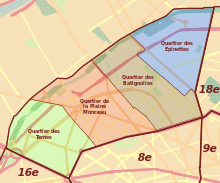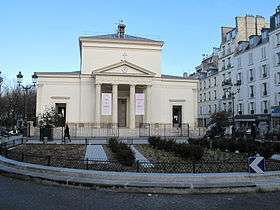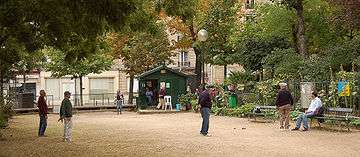Batignolles
Batignolles is a neighborhood of Paris, a part of the 17th arrondissement of the city. The neighborhood is bounded on the south by the Boulevard des Batignolles, on the east by the Avenue de Clichy, on the north by the Rue Cardinet, and on the west by the Rue de Rome.


History
Batignolles was an independent village outside Paris until 1860, when the emperor, Napoleon III, annexed it to the capital.
During the 19th century, Batignolles had an active cultural life, and it served as a base for the painter Édouard Manet and his friends, who became known as the "groupe des Batignolles". They painted many scenes of its café life.
21st century

Batignolles is outside the center of Paris most visited by tourists, but attractions include the Batignolles Cemetery (which is actually located in the nearby Épinettes district), and the Square des Batignolles a small park created in 1862.
It was intended that Batignolles would include the Olympic Village, had Paris hosted the 2012 Olympic Games. Former SNCF railyards were expected to be redeveloped as part of this process. It was intended that, after the Olympics (by 2015), the neighborhood would include 3,400 apartments, 30,000 square metres of shops, 140,000 square metres of office buildings and new public facilities (including a school and nursery). Moreover, major public buildings including the Palais de Justice court complex and the Police judiciaire building (previously located in the Île de la Cité), were expected to move to the new Cité judiciaire de Paris building, north of the garden.
The former railyards have instead been redeveloped into a new 4.3-hectare district,[1] centered on the new Martin Luther King garden.
Metro stations
Batignolles is:
| Located near the Métro stations: La Fourche, Rome and Brochant. |
It is served by lines 2 and 13.
![]()
![]()
Education
The Szkoła Narodowa Polska w Paryżu (Polish school in Paris) is in the Batignolles area.
Notes
- Archived January 27, 2012, at the Wayback Machine